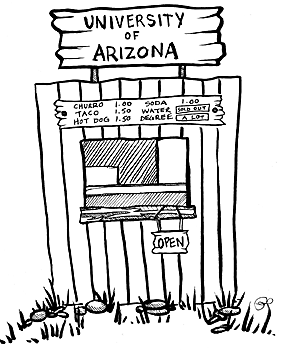
Illustration by Patricia Tompkins
|
|
By Katie Paulson
Arizona Daily Wildcat
Tuesday, November 15, 2005
Print this
Every year, a collective groan engulfs the campus as next year's tuition increases become public knowledge. Unfortunately, this year predicts a similar trend as rates will rise for both in-state and out-of-state tuitions as reported in yesterday's Wildcat.
As chagrined students seeking out needed funds from the already dire financial aid situation, it's time for us to discover the true use of our tuition money. But, more than that, we must fight for our right to receive a proper education from an entity that views us more as commodities than actual individuals.
While administrators, department heads and other puppets for the university chime together in their support of students' needs both academically and financially, they switch to vows of silence when questions of class availability and professor retention arise. Why does such a discrepancy exist?
Welcome to the world of privatization.
Similar to other public universities across the country, this school has slowly started to privatize means in order to keep the school afloat. Thus, university officials regard students as consumers interested in the "product" of education, which parallels the values of private enterprise in our capitalist system.
Of course, this method of higher education does have substantial benefits, especially in a state with such an atrocious reputation regarding education. Fernando Ascencio, Arizona Students' Association's director in charge of tuition lobbying, cites the recent decline in state funding as a need for alternative fundraising methods.
"Five years ago, the state budget offset 80 percent of the cost for each student attending an Arizona university while the student covered the other 20 percent. However, now the ratio stands at 65 percent from the state and the student is responsible for 35 percent," Ascencio stated.
Clearly, with a reduction in contributions from the state, options such as privatization make economic sense. Outside funding programs including donation solicitations and research and development laboratories generate funds that allow specific areas of the university to flourish.
However, privatization creates great rifts between multiple groups: students and the university; deans and administrative officials; and even students and students. Students must decide what's more important: keeping tuition at a low, stable level or keeping the university alive and universally affordable.
Dick Roberts, director and vice president of the Budget Office, explains that tracking tuition from student to overall university budget is not that simple.
In the numbers provided by Roberts, tuition will compose roughly 18.8 percent of the total UA operating funds for this academic year. However, to keep such a balance, tuition must increase in order to offset increased operating costs and minimal state contributions.
But, even with increased tuition, students are not seeing visible results in the fields that matter most. Besides the construction of new buildings such as the Student Union Memorial Center and Alumni Plaza financed through events such as Campaign Arizona contributions and directed donations, students continue to face enormous hurdles in order to achieve their bachelor's degrees.
Well, not all students struggle. Privatization appears more helpful to the sciences and other areas conducive to paid research opportunities. The liberal arts colleges, bombarded with budget cuts and lack of replacement funds, have seen the most negative impact regarding fulfilling student's basic needs - classes, advising and outside internships.
The recent trauma of journalism students and the always-chaotic world of political science reveal the downward spiral exhibited by such liberal arts colleges. However, the deans and department heads are not actively engaged (at least verbally) in finding a solution.
In order to complement the privatization track embodied by other university colleges, liberal arts colleges need to develop new plans in order to draw in funding. Some ideas include forming partnerships with outside companies that could provide internships, research and development opportunities, and sponsorships for events.
If such alternatives don't provide viable solutions, the other extreme: cut programs. In the UA's plan for Focused Excellence, liberal arts colleges remain intact but less crucial, which implies less monetary support. Hence, if certain programs can't make the grade, don't allow students to attempt completion only to experience hardships in order to graduate in some reasonable amount of time.
Perhaps it's unfair to label administrators as apathetic toward the needs of students. But, in this shift toward privatization and increased tuition for the sixth year in a row, the old adage of "actions speak louder than words" rings loud and clear.
Katie Paulson is a junior majoring in English and political science. She can be reached at letters@wildcat.arizona.edu.
